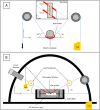The Effect of Gelatin Molecular Weight on Tendon Lubrication Utilizing an Extrasynovialized Turkey Flexor Tendon Model
- PMID: 33499438
- PMCID: PMC7980492
- DOI: 10.1093/milmed/usaa265
The Effect of Gelatin Molecular Weight on Tendon Lubrication Utilizing an Extrasynovialized Turkey Flexor Tendon Model
Abstract
Introduction: Flexor tendon injuries are common hand injuries among the military population often resulting in functional impairment. Flexor tendon gliding friction has been linked to adhesion formation, especially with the use of extrasynovial grafts. Carbodiimide-derivatized hyaluronic acid with gelatin (cd-HA-gelatin) can reduce gliding friction of the tendon graft; however, the effects of gelatin molecular weight (MW) have not been studied. The turkey model has been shown to better match humans, but extrasynovial tendons are unavailable. The purpose of this study was to (1) manually roughen turkey flexor digitorum profundus (FDP) tendons to simulate extrasynovial tendons and (2) investigate the effects of gelatin MW on tendon friction.
Materials and methods: The third digit of (n = 48) turkeys were dissected with the proximal pulley, and FDP tendon and the flexor superficialis tendon were preserved. Digits were randomly assigned into four groups: one saline control and three cd-HA-gelatin-treated groups of varying gelatin MW. Flexor digitorum profundus tendon friction was measured at its original condition, serving as a baseline. Tendons were roughened using a custom rig, and tendon friction was measured again. All four groups received treatment and gliding friction was measured every 100 cycles to a total of 1,000 cycles.
Results: Tendon friction significantly increased (P < 0.05) after roughening. Friction in the saline control group increased steadily over repeated cycles, whereas friction of all gelatin-treated tendons decreased significantly compared with the saline control group (P < 0.05), maintaining low friction to 1,000 cycles representing human tendons. There was no significant difference found between gelatin-treated groups.
Conclusions: We have developed a method to roughen synovial FDP tendons to create extrasynovial-like tendons for lubrication material evaluations. Cd-HA-gelatin effectively reduces tendon friction in this model. Our data suggest medium or low MW gelatin may provide a better reduction in friction compared with high MW gelatin.
© The Association of Military Surgeons of the United States 2021. All rights reserved. For permissions, please e-mail: journals.permissions@oup.com.
Figures




Similar articles
-
Lubricin surface modification improves extrasynovial tendon gliding in a canine model in vitro.J Bone Joint Surg Am. 2008 Jan;90(1):129-35. doi: 10.2106/JBJS.G.00045. J Bone Joint Surg Am. 2008. PMID: 18171967
-
Reducing friction by chemically modifying the surface of extrasynovial tendon grafts.J Orthop Res. 2004 Sep;22(5):984-9. doi: 10.1016/j.orthres.2004.02.005. J Orthop Res. 2004. PMID: 15304269
-
Lubricin surface modification improves tendon gliding after tendon repair in a canine model in vitro.J Orthop Res. 2009 Feb;27(2):257-63. doi: 10.1002/jor.20731. J Orthop Res. 2009. PMID: 18683890 Free PMC article.
-
Gliding resistance and modifications of gliding surface of tendon: clinical perspectives.Hand Clin. 2013 May;29(2):159-66. doi: 10.1016/j.hcl.2013.02.001. Epub 2013 Mar 15. Hand Clin. 2013. PMID: 23660052 Free PMC article. Review.
-
Hyaluronic acid and tendon lesions.Muscles Ligaments Tendons J. 2016 Feb 13;5(4):264-9. doi: 10.11138/mltj/2015.5.4.264. eCollection 2015 Oct-Dec. Muscles Ligaments Tendons J. 2016. PMID: 26958533 Free PMC article. Review.
References
Publication types
MeSH terms
Substances
Grants and funding
LinkOut - more resources
Full Text Sources
Other Literature Sources

